#andy pye
Video
youtube
Pye Corner Audio (ft. Andy Bell) - Warmth of the Sun (from Let’s Emerge)
Great new album out from Martin Jenkins aka Pye Corner Audio!
#pye corner audio#andy bell#warmth of the sun#let's emerge#martin jenkins#sonic cathedral records#electronic#music
2 notes
·
View notes
Audio
Pye Corner Audio’s got a new one out, too: Let’s Emerge! (with Andy Bell on guitar for 5 tracks)
‘Let’s Emerge!’ is Pye Corner Audio’s first studio outing for Sonic Cathedral following the acclaimed live recording ‘Social Dissonance’, and it features Ride guitarist Andy Bell playing on five of its ten tracks.
From the first glimpse of the artwork to the first note of the music it’s a marked deviation from Pye Corner Audio’s more traditional shadowy sounds. Whereas his last outing for Ghost Box (2021’s ‘Entangled Routes’) was inspired by the underground fungal pathways through which plants communicate, this one is very much above ground, bathed in sunlight and acid-bright psychedelia.
“This is a departure to sunnier climes, but a departure nonetheless,” says Pye Corner Audio, aka Martin Jenkins. “It’s something that I’d been thinking about for a while. I try to tailor my work slightly differently for the various labels that I work with, and this seems to fit nicely with Sonic Cathedral’s ethos.”
“The last few years have seen huge changes, both personally and in a wider perspective. The album title is a reaction to this, a collective (tentative) sigh of relief. Here’s to new beginnings and a sense of hope.”
Guitars on 1, 2, 4, 6 and 10 by Andy Bell
5 notes
·
View notes
Text
#spotify#music#playlist#friday#roy montgomery#piano magic#launder#hunters & collectors#killdozer#kamikaze nurse#the soft moon#srsq#pye corner audio#andy bell
1 note
·
View note
Text
ROLLING STONES SONGS: 'OUT OF TIME' (Metamorphosis version, 1975)
Rolling Stones songs: Out of Time (‘Metamorphosis’ version)*Click for MORE ROLLING STONES SONGS 1962-PRESENT
My poor discarded baby/ I said, baby, baby, baby, you’re out of time…
Written by: Jagger/RichardRecorded: Pye Studios, London, England, Apr. 2730, May 6 1966 Guest musicians: Jimmy Page, Joe Moretti, Eric Ford, Reg Guest, Andy White, Sydney Sax, Chris Farlowe*Data taken from Martin…
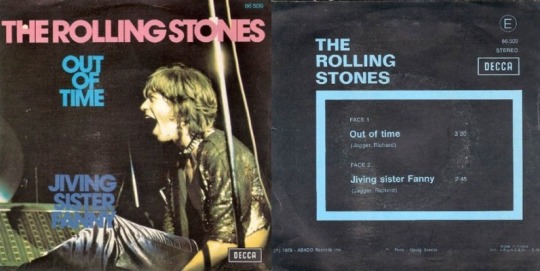
View On WordPress
1 note
·
View note
Text
Reviews 348: Expositions
I came to the music of Reuben Smith through Balearic Social Records, who included “Venezuela” on the Sola various artists EP back in 2017. Released under the name Calle Gravina, the song was a total revelation and saw tropical mallet instrumentation dancing alongside big bottomed synth basslines, beachside downbeats, and psychedelic wah licks while equatorial synthesizers fluttered on a seabreeze. And best off all, the track featured a truly jawdropping “Na Na Na” chorus that truly must be heard to be believed, for so powerful is its effect that words simply fail me. In the time since the release of “Venezuela,” I’ve often dreamed about more music from Reuben and finally, after three years of waiting, my patience has been rewarded in ways I couldn’t have imagined, for the artist is making a big splash in 2020 via a new project named Expositions. The first release from Expositions and the focus of this review is the Yellow Haze EP, which was recently put out by the ever-amazing Forest Jams, a label that never fails to blow me away and who I last checked in with via the California coastal psychedelia of Starving Daughters. Here, the pairing between label and artist couldn’t be more sympathetic, for across the EP’s four tracks, Reuben moves smoothly between sunset downtempo, island life dubfunk, slow motion boogie, and seaside fusion, as subsonic basslines slide sensually, synthesizers fall like a summer storm of gemstones, shakers and tambourines add touches of beachdance swing, solar space leads swim in stoner splendor, palm-muted echo riffs dance on sunbeams, and fat bottomed balearic beats guide the body through exotica bongo and conga tapestries. And in crucial moments of soulful pop euphoria, a vocalist named Hanna delivers delirium diva incantations awash in an Ibizan chill-out dreamhaze...her voice sometimes joining Reuben’s for dopamine hooks, while at other times floating off into the ether.
As well, I’d like to briefly discuss the second Expositions EP Nights at Casa Ana, which is already in the works via a Qrates crowdfunding campaign found here. I encourage readers of this blog to back the pressing if possible, as the release is truly special and deserves its place on wax. Moreover, Nights at Casa Ana sees the welcome return of the aforementioned Balearic Social Records, a favorite label of mine that has been lying low since 2018’s Nyala split EP between Bonnie & Klein and BlackBush Orchestra. Though Nights at Casa Ana still revels in familiar vibes of sunshine positivity and oceanic radiance, the EP sees Reuben moving slightly away from downtempo pop towards fever dream fantasies and drug-induced paradises, which is nowhere more apparent than on the near 15 minute “Energía Mística.” The track is a slowed seaside disco epic, featuring nimble funk basslines, kaleidoscopic guitar refractions, blissful fusion leads, layers of solar squelch, fourth world dub electronics, acid fuzz space solos, and snippets of spoken Spanish flowing in and out of birdsong…the whole thing comprising a journey in extended balearic jamming only rivaled by Max Essa’s “Panoramic Suite.” As for the other two tracks, we are treated to shorter, though no less expansive adventures, both featuring acid house bassline percolations and further trippy Spanish spoken word sampling. “Misteriosi” sets a filmic dancefloor gallop beneath jangling western guitars, sea-crystal melodies, mellotronic prog flutes, sci-fi synth leads, chanted breaths, and layers of extasy laughter while in “Tomate tu tiempo,” machine beats lock into a samba-esque swing, AOR guitars ride a warming summer wind, marimba fractals surround woodwind lullabies, soulful chords stoke vibes of 70s disco intoxication, and starbeam fusion solos dance through layers of seaspray while neon-hued acid tracers fire gently across the mind.
Expositions - Yellow Haze (Forest Jams, 2020)
Shakers and sonar sequencers set the stage in “Get With You” before cutting away to slinky bass guitar riffage and a slow motion balearic breakbeat, with touches of boom bap kissing the rhythmic flow. Static textures swoosh around smooth Rhodes riffs as the basslines hit ever heavier and high in the sky, synthesizers radiate Italo fusion lullabies and new age starscapes amidst cooing vocal accents. After a drum fill eruption, we drop into paradise pop intoxication, with Reuben’s and Hanna’s hazy vocal hooks trailed by soulful Rhodes chord flourishes…the whole thing like a supremely stoned out _Moon Safari-_era Air cut. Underneath, tapped rides shake out golden glitter, snares crack on the beat, and basslines execute funky octave walks while later, after a brief cut into dreamhouse pianos and slow motion disco drums, a run down the ivories ushers in a symphonic paradise climax awash in pads that breath like celestial ether. Then, following another delirium chorus accented by tambourine jangles and liquid wah wah gurgles that flutter outwards in every direction, the track ends with synth solo dazzlement, as laserlight runs ascend on ocean-filtered sunbeams amidst mechanized ride bells, swinging shaker hypnotics, crashing cymbals, and Hanna’s ethereal vocal shadowspells. “Rollerskates” follows with its spaceage harpsichord/steel pan synths layering a rainfall of percussive ocean crystal over shakers and robotic slapbass weirdness. As the groove drops in, we find ourselves in a broken beat dub out, with hi-hats spitting fire on a skanking riddim, lofi snares popping off the beat, and layers of angel starlight and nacreous vocal chaos swirling all around. It’s a doped out boogie beat groover in the style of A Vision of Panorama, wherein crystalline keyboard chords and Carribean steel leads swim through rainbow gases, low down vocal drones filter into cut-up trance euphoria, and meditative whistle tones ensnare the mind. After a quick drop, snare fills bring back the jam, which now seems to squiggle and shimmer with an almost nervous sense of energy, and as the rhythms continue pulling in and out, pianos scat out blues-tinged reggae riffs amidst gaseous bodies of choral star magic. And as the futuristic harpsichords and synthetic island idiophones continue bouncing alongside the dubwise boogie rhythms, one can easily imagine a boardwalk scene where myriad skaters glide graciously beneath a shining sun.
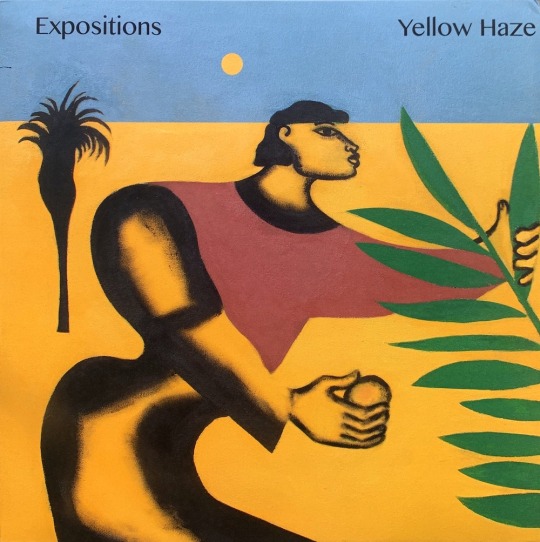
In “Sun Shine Down,” galactic pads swirl amidst crashing waves as hand drums hint at a blossoming beat. Then comes the groove proper, wherein distorted basslines generate huge wavesfronts of subsonic romance, tick-tock cymbals move around pounding kicks and cracking snares, and Hanna sings spells of shadowy wonderment…her lyrical phrases and wordless extasy reveries calling to mind Cathy Battistessa’s work with balearic masters such as Afterlife and Blank & Jones. At certain moments, feedback synths evoking both seagulls and diamond sparkles melt over the mix while piano chords hit like neon liquid. Elsewhere, during understated climaxes, these amazing polysynth melodies start descending…as if discretized pulses of psychedelic starlight are dancing across a sunset sky. All throughout, massive basslines slide with a fluid grace, bongos blow in on a coastal breeze, and hissing cymbals open up into heatwave blasts, with heady rhythmic drop stoking vibes of anticipation. And as the the track ends, a blazing fusion synth solo works into the stereo field…slow and sensual…with trippy modulation wiggles interspersing the paradise glide. Yellow Haze ends with “Holding On,” which drops into a bottom heavy heroin groove seeing palm-muted echo guitars moving lackadaisically over a dubfunk pulse. Basslines hit low before sliding high, shakers and cymbals guide the body, and tropical hand percussions spread out as Hanna executes dazzling soul diva reveries, with her voice occasionally trailed by coral-colored synth harmonizations. A towering tom fill cuts the groove down to tapped rides, spitting hats, and pooling bodies of liquid synthesis while later, as the kick, snare, and bass synths slam the body into oblivion, wah wah electronics spread outwards into a ghostly sea haze while e-pianos communicate with dolphins and whales. During a magnificent synthesizer solo, bluesy fusion leads filter and bend as the basslines move in tandem with the beats…the vibe bleary eyed and stoned out before reducing to a Floydian pulse, one overplayed by strange bell-tone cacophonies. Building back, tambourines jangle and guitars generate psychosonic dub lick and echo-morphing funk riffs beneath a cascade of vocal starlight before the downtempo body groove finally slams back in, with the stereo field now overflowing with wavering webs of crystallized vibrato while Italo-style squelch leads seek out the sun.
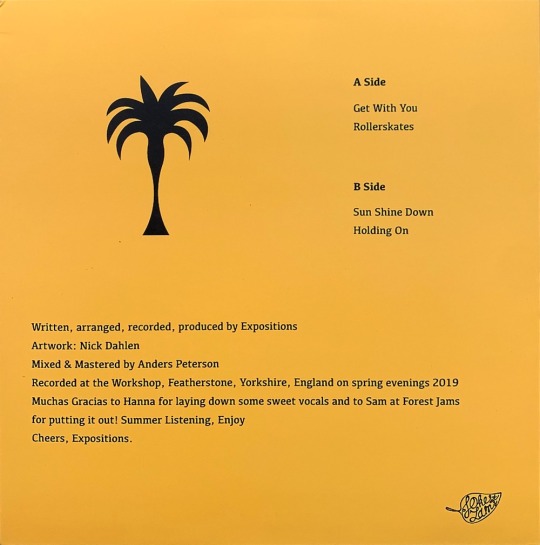
(images from my personal copy)
#expositions#reuben smith#hanna#calle gravina#balearic social#balearic social records#andy pye#outlaws yacht club#balearic#balearic beat#yellow haze#forest jams#seaside pop#fusion#funk#dub#boogie#rollerskating#tropical#equatorial#magical#narcotic#blissed out#summer listening#artwork by#nick dahlen#album reviews#vinyl reviews#music reviews#vinyl
4 notes
·
View notes
Text
me when i’m singing to old fall out boy songs where literally nobody knows what patrick is singing:
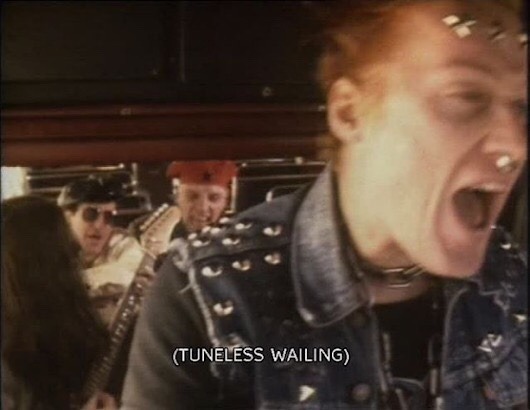
#the young ones#tyo#rick pratt#vyvyan basterd#mike the cool person#neil wheedon watkins pye#rik mayall#ade edmondson#nigel planer#christopher ryan#fall out boy#patrick stump#pete wentz#andy hurley#joe trohman#fob
56 notes
·
View notes
Text
The Indica Gallery és el mini disc de remescles d'Andy Bell (Ride) i Pye Corner Audio (2021)
@Andybebop Gènere: #electronic #remixes #songoftheday The Indica Gallery és el mini disc de remescles d'Andy Bell (Ride) i Pye Corner Audio (2021)
@Andybebop Gènere: #electronic #remixes #songoftheday
Per avui tenim remixes. El guitarrista de Ride, el nostre estimat Andy Bell presenta un EP de remescles de sis pistes, en col·laboració amb el projecte Pye Corner Audio, aka, Martin Jenkins.
“The Indica Gallery” EP inclou cinc reelaboracions de cançons de l’àlbum en solitari de Bell de l’any 2020 del seu àlbum “The View From Halfway Down”.…
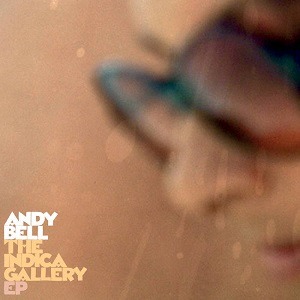
View On WordPress
0 notes
Photo
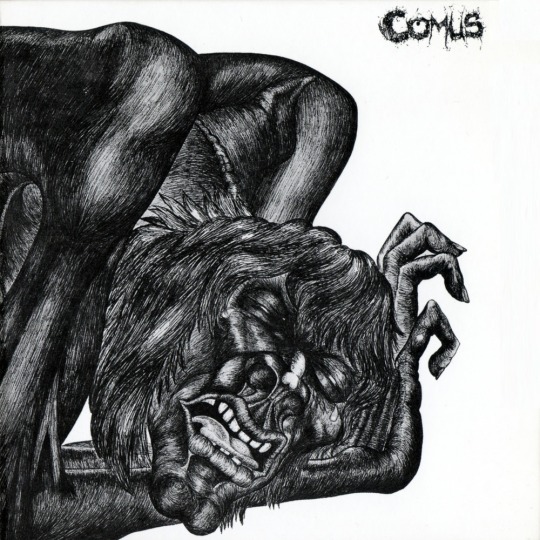
Storia di Musica #218 - Comus, First Utterance, 1971
Quelli che hanno ancora voglia di leggere delle mie storie di musica (che ringrazio con infinita gratitudine) sanno che una delle mie passioni musicale è il progressive. Tra le storie incredibili di quegli anni, meravigliosi musicalmente parlando, una delle più suggestive inizia nel 1967 in un college di Arte del Kent, a Bromley: lì Roger Wootton e Glenn Goring giovani chitarristi, si conoscono e mettono su l’idea di costituire una band. Hanno una comune passione per il lavoro di John Renbourn e di Bert Jansch che in quegli anni erano i principi del fingerpicking. Ai due si aggiungono Chris Youle e lo studente di scienze della comunicazione Colin Pearson, poco dopo Andy Hellaby, bassista, si unisce ai nostri dopo che li aveva sentiti suonare in un locale della zona, l’Arts Lab di Beckenham, che all’epoca aveva tra i gestori un certo David Bowie. Manca una voce femminile, e viene scelta quella eterea e suggestiva di Bobbie Watson, che nel 1967 ha solo 16 anni. Ultimo ad entrare nel gruppo è il flautista Michael Bammi Rose, che risponde ad un annuncio inserito dai nostri sulla prestigiosa rivista musicale Melody Maker, che però abbandonerà dopo un anno, sostituito da Rob Young, amico di Pearson e della Watson. Young è un pianista, ma proprio in vista del suo ingresso nella band, studia e apprende da sé flauto, oboe e percussioni. Youle, che nel frattempo è diventato il manager della band, suggerì un nome fantasioso al gruppo, Comus: avendo studiato John Milton, che la riprende in una sua opera (Comus. A Masque Presented at Ludlow Castle, 1634) , Comus è la personificazione del komos, cioè la divinità dell’euforia dionisiaca. Va detto che non è menzionata nella mitologia antica ma compare unicamente con riferimento all'arte figurativa, e l’esempio più famoso è quello che Filostrato nel III secolo d.C. descrive da un affresco di una villa della costa napoletana: un giovane alato e sbronzo, con le gambe incrociate, dal volto paonazzo e il capo reclino sul petto, con una lancia e una torcia rovesciata tra le mani. E qui sta forse l’ispirazione alla musica che il gruppo ha in mente: se la partenza è la rinascita del folk che in quegli anni porterà a risultati clamorosi (i Pentangle, i Fairport Convention, Sandy Denny fino ad arrivare alle suggestioni folk dei Led Zeppelin) qui si vira in atmosfere terrificanti, dove il particolare utilizzo degli strumenti e della voce sia di Wotton che della Watson darà risultati di una bellezza sinistra e a tratti di una bellezza inquietante. Esempio clamoroso e definitivo in questo fu un concerto all’Arts Lab, presente Bowie, dove per una corda della chitarra lacerata Wotton si tagliò inavvertitamente un dito, ma continuò imperterrito a suonare una cover di Venus In Furs degli amati Velvet Underground con la chitarra che piano piano diventa arrossata di sangue, per la gioia del Duca Bianco che li aiutò a trovare un contratto. La prima prova di un certo peso fu la collaborazione con il regista Lindsay Shonteff, uno dei massimi registi di b-movie inglesi, presente anch’egli alla “sanguinosa” perfomance: per lui scrissero la colonna sonora di un oscuro film soft porno, Permissive del 1971, e dopo la pubblicazione del loro primo disco, nel 1973 quella di un action movie, Big Zapper. Nel mezzo, ottengono un contratto per la Pye Records e nel 1971 esce il loro primo album, First Utturance (La Prima Enunciazione). Probabilmente mai si era sentito un disco del genere: un disco dove la musica folk accompagna un campionario di paure, tensioni, umore nero e diabolico di un fascino in certi momenti irresistibile, dove il bucolico interesse per la musica tradizionale si tinge di fosche tinte diaboliche e misteriose, in un mix irresistibile e portentoso. Partendo dal mito miltoniano di Comus, il gruppo racconta di un inseguimento ansiogeno tra la malvagia divinità e una deliziosa fanciulla in Diana, singolo del disco, dove la voce angelica della Watson si scontra con i vocalizzi da indemoniato di Wotton e degli altri in un duello serrato, con il contrappunto di un diabolico violino e di un clamoroso assolo di tamburi tribali, per una violenza musicale (e carnale nei testi) che è in bilico fino alla fine. Il tutto si stempera nei 12 favolosi e bucolici minuti di The Herald, una canzone che contiene un mondo di magia e di pace, di luce e di gentilezza che scompaiono nel resto del disco. Drip Drip ne è l’esempio lampante: un inno alla violenza, al piacere che dà il sangue che gocciola dalla lama che ha trafitto la carne (da cui il titolo), alle sensazioni di straniante euforia nel portare un corpo alla sua tomba, uno dei brani più estremi della storia della musica occidentale, dal mefistofelico e inquietante testo: Questa sarà la nostra ultima comunione fisica\Sarò gentile con te, non ti farò del male\ Ti amo. Song To Comus è l’invocazione per chitarra, percussioni e flauto al rituale dionisiaco che al komos si rifà, in un brano che è la via di congiunzione tra il folk, un flauto che ricorda quello di Ian Anderson dei Jethro Tull e la magia oscura dei Velvet Underground. La diade Bite – Bitten, quest’ultima un piccolo intermezzo strumentale, sembra una successione di incubi, isterici e soffocanti. E non manca nemmeno la malattia mentale, nella spettrale e intensissima The Prisoner cantata dal pazzesco Wotton come un dialogo di uno schizoide paranoico con le sue voci interiori, metaforicamente incarnate dalla voce della Watson, in un brano che è anche un manifesto contro l’isolamento dei malati mentali. Nelle versioni moderne del disco, ci sono la versione singolo di Diana, e altri gioiellini oscuri: In The Lost Queen's Eyes e Winter Is A Coloured Bird ma soprattutto un brano, meraviglioso, che racchiude la loro poetica, All The Colours Of Darkness, con la voce magica e spettrale della Watson. Il disco non ebbe nessun riscontro commerciale, si dice abbia venduto solo 10 mila copie: ma come molte volte accade, ha lasciato un’aura leggendaria, in questa caso una leggenda nera e tenebrosa. Nel 1974 pubblicano un secondo disco, To Keep From Crying, che non è nemmeno male, ma non è minimamente paragonabile al malsano fascino di questo disco incredibile, che ha una storia particolare persino sulla copertina: l’uomo che si trascina strisciando con così tanto dolore è opera di Wotton, che lo disegnò con una biro nera durante un corso all’Art College che frequentava. La loro vicenda ebbe una clamorosa riscoperta quando gli Opeth, la formidabile band svedese del goth rock, usarono un verso del testo di Drip Drip per il titolo del loro disco del 1998 My Arms, Your Hearse: As I carry you to your grave, my arms your hearse ("mentre ti conduco alla sepoltura, le mie braccia sono il tuo carro funebre"). Gli stessi Opeth in The Baying Of The Hounds, da Ghost Reveries del 2005, utilizzano un passaggio del testo di Diana (And she knows by the sound of the baying, by the baying of the hounds). Sotto la spinta di questo nuovo interesse, la band si riforma in formazione quasi completa, con Young sostituito da Jon Seagroatt, marito della Watson e sassofonista e tastierista dei Colins of Paradise: con questa formazione pubblicano un disco nel 2012, Out Of Coma, che riprende la grafica della copertina di First Utterance e rielabora un brano, The Malgaard Suite, pensato in quegli intensi e febbrili mesi dei primi anni ‘70. Rimane un disco di un fascino sinistro e irresistibile, suonato magnificamente, dove la voce di Wotton sembra quella di tre cantanti diversi, per un viaggio sonoro incredibile e che ha pochissimi paragoni nella storia della musica rock.
15 notes
·
View notes
Text
The 2021 list
Everything in quotes “” have no artist details or no info could be found when going through the emails. these are probably part of an archive .zip / .rar
If you identify these titles as yours, let me know.
If there are typos ( more than likely) again, let me know.
[ some names seem to have been removed by the far too efficient text file alphabetical sorting thingy. ]
"2021 07 28"
"2021 May 19"
"abandoned4"
"brief theme for ending things"
"buddhaone"
"build 3"
"delprado hotel"
"dissolved metal salts that coat your lips with a bitter film"
"Dorv 2"
"dying"
"Encounter TK1"
"enddub.blk"
"Evangelica Church Group Birmingham"
"experiments 5"
"first breath comma second breath"
"Foghorns Rough"
"Frequency Scanning"
"Gurenda"
"hello 2&3"
"indulgent overtones"
"intro"
"jen edit"
"lonely waits"
"lotafun 21"
"nextex it"
"no, I think someone is recording us"
"omniglot"
"premix rough"
"prince earl"
"Ratchets 7"
"render navina"
"see the sun"
"skipping new"
"soundscape"
"soundtrack"
"TDO5"
"Theme from Public Transport"
"TMC-06"
"track 01"
"turbu"
"unmastered"
"wavestation"
"zoom016"
1 of 100
1976
8 Track Dogma
A Farewell to Hexes
Accursed Volts
Ada Stockwell & Lippy Kid
Adi Carter
Adjectivals
Afrotull
Aldo Rox
AM Web
Amongst the Pigeons
Andrea Careddu
Andrew Ramsey
Andy Blip
Andy McDade
Another Dead Weirdo
Antoni Maiovvi
AOTCI
Apalusa
Apta
Arvik Torrensen
Assassin of Sound
Audio Obscura
Aula Deft University of Technology
Autoflag
Autumna
Ave Grave
Awful Collider
baze.djunkiii
Bazrah
Ben Tye
Bernard Grancher
Betamax Warriors
Bipolar Explorer
Bit Cloudy
Blaiddwyn
Bless This Machine
Blood Everywhere
BMH
Boodlam
British Detail
Calico Jack
Capricornio
Cevan
Charlie & Lol1
Chelidon Frame
CLAIR
Claro Correcto
Co-Pilot
Course Correct
Cowboy Flying Saucer
Cuts
D. McCann
D. Taylor
Daft
Danny Carnage
Darren Hannant
Datassette
David McNicol
Desert Petunia
dESUS
DFF Sound System
Ditchburn Band
Distant Animals
Dog in the Snow
[dOOM] dESUS
Drew Five
Dundass
Dusty Ohms
Earthborn Visions
Earthshine
Eat the Sun
Ed Spess
Eduards Ozoliņš
Egone
El Ghou
Electric Talk
Electroaurora
Elizabeth Joan Kelly
Elli Shnoo
Em Downing
Eoin MacIonmhain
Espetacara
EV
Everon Goen
Exit Chamber
Famished for Blonds
Fantasy Sequence
Finlay Shakespeare
Flexagon
Forces of Good
Four Italian Pep Pills
Fragile X
From the Benthic Zone
Garden of Surreal Dreams
Gasmantell
Gemma Cullingford
Georgia
Gone Caving
Grant Basma Horsnell
Grant Forrester
Gusset
Half
Hazard Radio
Heavy Cloud
Hengist Pod
Hi-Tech Criminal
Hirsig
Hole in the Machine
Holmes & Atten Ash
Holychao
Hornbeam
Human Concept
Hymettus Woods
Idiogram
JD Twitch
Jack Blake
Jackaman
James Graham
James Oldrini
James Sandford
Jamie Cameron
Jane Pitt
Juxtagon
Jeff Styroid
Jim Jarmo
Joe Ahmed
Joe Muggs
Joel Shea
John Rushton
Jonathan Higgins
Junklight
Junkyard of Silenced Poets
K.
Karl D'Silva
Kate Arnold
Kim Moore
Kinver Pond
Kitty Turner
KKP 1489
Komputer
L/F/D/M
Lament_Config
Lathave Park
Lefthave Plank
Leiyun
Leptonandon
Levi Fuller
Liam Kendal
Limited Ability
Lomond Campbell
Louzy
Luke Hansbury
Mabel Gwen vs Rusty Sheriff
Malady of Knots
Mark Healy
Mark Wilkins
Masios
Matt Nix
Matthew McCourt
Matthew Thomason
Meadow Pixie
Mechanical Lobster
Megalophobe
Melony Klein
Miriam Ingram
Meridian
Michael Begg
Michael Denny
Mike Smalle
Mike Tupling
Milk and Cheese
Millz Davis
Mitsubishi Cunliffe
Mode 7 Project
Modulator ESP
Moray Newlands
Mr Kong 95
Mr Kristoffa
Museleon
Mute Frequencies
Myrrhman
Nad Spiro
Nat Lyon
Naylee
Negative Response
Neve
Nicolas Corniglion
Nonalogue
Old Man
Oliver Lacon
OOO EEE OOO
Openchannel
Outside Other
Owen Sound
P6
Palmer Eldritch
Panamint Manse
Passenger Pieon
P. G. Warren
pHactory
Portobello Drone Choir
Posthuman
Pracownik
Prequel Tapes
Prince Video
Production Unit
Pye Corner Audio
Rave Sir Robin
Re:Search
Remote-Control_Rectum
Repeared Viewing
Richard Sandling
RJ Ellmer
Robert Griffiths
Roberta Fidora
Robyn Gibson
Rockets in the Trees
Roland Oakes
Ruaridh Law
Sadie Maskery
Saguenay
Salford Electronics
Salvatore Mercatante
Samantha Fox
Sansuro 77
Scanner
Scott Smigiel
Scumbag Radio
Seapup
Secret Nuclear
Security
Semispecific Ensemble
Schestokken
Shiranai Hito
Sheer Zed
Signal
Signal Jammer
Silas Andersen
Simon Fisher Turner
Simon Heartfield meets Megaheadphoneboy
Sizike
Skeleton Worm
Slateford Mods featuring MC Dead Kennarty
Slow Down Missy
Snooks
Solo1
Soundhead
Spacelab
Spiral Dial
St James Infirmary
Stephen Boyle
Steve Emerson
Stock Photography
Strangest Pet on Earth
Stuart Cook
Subversive Recluse
Swardh
Tambay
Teishi-1
Time Destroys All Things
The Bookshop
The Cairnsmore Conspiracy
The Domestiques
The Family Germ
The Last Ambient Hero
The Leaf Library
The Nameless Book
Thee Adversary
Thelonius Martin
Todd Snow
Tom gunn Nash
Toxic octopus
UBO
Unseen Hands
Veryan
Vitruvian Skies
Von Heuser
Walthamstow Home Keyboard Laboratory
Warrior Bob
Waves of Nightinglaes
William Wild
Wizards Tell Lies
Writers Bloc
Xelis De Toro
Yol
Yvette Haynes
4 notes
·
View notes
Photo
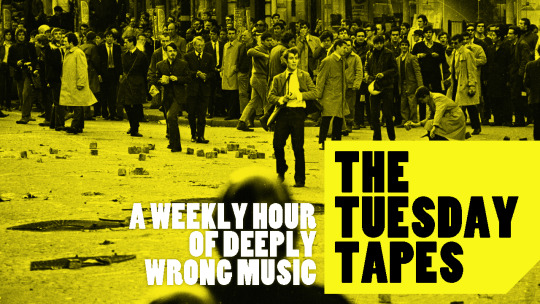
THE TUESDAY TAPES
MARTEDÌ 25 MAGGIO 2021
1) MAXWELL FARRINGTON & LE SUPERHOMARD > Good Start
2) FOLLY GROUP > Sand Fight
3) ROCKERS HI-FI > Seven Shades of Dub
4) RÓISÍN MURPHY > Hardcore Jealousy
5) SWEET EXORCIST > Test Four
6) THE JUAN MACLEAN > I Can’t Explain (Alinka mix)
►► 6 TRACKS FROM “SHAKE THE FOUNDATIONS” BOX
7) A CERTAIN RATIO > Guess Who
8) SHOCK > Dream Games
9) MATAYA CLIFFORD > Living Wild
10) THE ELECTRIC CHAIRS > So Many Ways
11) MAXIMUM JOY > Stretch
12) THE PASSIONS > Skin Deep
13) ANDY BELL & PYE CORNER AUDIO > Cherry Cola
(PS: se non visualizzate il widget, lo streaming della puntata è QUI)
3 notes
·
View notes
Photo

Andy Bell - See My Friends
UK EP - 2021
01. The Commune [Pye Corner Audio Remix]
02. Plastic Bag [Pye Corner Audio Remix]
03. The Commune
04. Plastic Bag
3 notes
·
View notes
Text
Nifty 50 of 2021 - The Albums
The annual tradition lives on! Here is my gift to you, the Nifty 50 for 2021. A list of all the albums that made an impact on me over the year. 2021 was yet another incredible year for music! Both the Spotify list and YouTube list are included below (some great videos to go with those releases too!). No particular order to these, just how I saw them going together.
Enjoy, and Happy Holidays!
Spotify playlist
https://open.spotify.com/playlist/0t9MbtnikG41vu9LIt0uTr?si=b0eed67c0cb64b4b
YouTube videos playlist (select play all)
https://youtube.com/playlist?list=PLqUMf7mP_mnMvwRKJVgeGgGx1lxoxGQMC
Steven's Nifty 50 of 2021 - The Albums
01. Japanese Breakfast – Jubilee
02. Snail Mail – Valentine
03. Faye Webster – I Know I’m Funny haha
04. Andy Shauf – Wilds
05. Arlo Parks – Collapsed In Sunbeams
06. The War On Drugs – I Don’t Live Here Anymore
07. The Weather Station – Ignorance
08. Art School Girlfriend – Is It Light Where You
09. Film School – We Weren’t Here
10. Still Corners – The Last Exit
11. Wolf Alice – Blue Weekend
12. Julien Baker – Little Oblivions
13. Nick Cave & Warren Ellis – CARNAGE
14. Hand Habits – Fun House
15. Half Waif – Mythopoetics
16. Goat Girl – On All Fours
17. Mogwai - As the Love Continues
18. Teenage Fanclub – Endless Arcade
19. Parquet Courts – Sympathy For Life
20. The Bug Club – Pure Particles
21. Kiwi jr. – Cooler Returns
22. Ducks Ltd. - Modern Fiction
23. The Reds, Pinks and Purples – Uncommon Weather
24. Dry Cleaning – New Long Leg
25. Viagra Boys – Welfare Jazz
26. TV Priest – Uppers
27. Amyl and The Sniffers – Comfort To Me
28. IDLES – Crawler
29. Delvon Lamarr Organ Trio – I Told You So
30. Curtis Harding – If Words Were Flowers
31. Durand Jones & The Indications – Private Space
32. La Luz – La Luz
33. La Femme – Paradigmes
34. Jane Weaver – Flock
35. Vanishing Twin - Ookii Gekkou
36. Snapped Ankles – Forest of Your Problems
37. LoneLady – Former Things
38. ACTORS – Acts of Worship
39. W.H. Lung – Vanities
40. Nation of Language – A Way Forward
41. Black Marble – Fast Idol
42. Pye Corner Audio – Entangled Routes
43. Hannah Peel – Fir Wave
44. For Those I Love – For Those I Love
45. Bicep – Isles
46. Christian Löffler – Parallels: Shellac Reworks
47. Floating Points, Pharoah Sanders, London Symphony Orchestra – Promises
48. A Winged Victory For the Sullen – Invisible Cities
49. Loscil – Clara
50. Jon Hopkins – Music For Psychedelic Therapy
3 notes
·
View notes
Photo
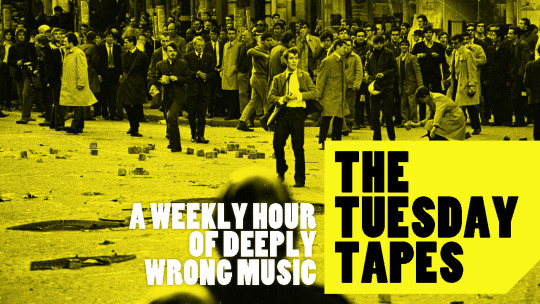
THE TUESDAY TAPES
MARTEDÌ 25 MAGGIO 2021
1) MAXWELL FARRINGTON & LE SUPERHOMARD > Good Start
2) FOLLY GROUP > Sand Fight
3) ROCKERS HI-FI > Seven Shades of Dub
4) RÓISÍN MURPHY > Hardcore Jealousy
5) SWEET EXORCIST > Test Four
6) THE JUAN MACLEAN > I Can’t Explain (Alinka mix)
►► 6 TRACKS FROM “SHAKE THE FOUNDATIONS” BOX
7) A CERTAIN RATIO > Guess Who
8) SHOCK > Dream Games
9) MATAYA CLIFFORD > Living Wild
10) THE ELECTRIC CHAIRS > So Many Ways
11) MAXIMUM JOY > Stretch
12) THE PASSIONS > Skin Deep
13) ANDY BELL & PYE CORNER AUDIO > Cherry Cola
Ascolta su MIXCLOUD
Ascolta su SPREAKER
Guarda su YOUTUBE
#maxwell farrington#le superhomard#folly group#roisin murphy#cherry red records#post punk#music podcast
2 notes
·
View notes
Audio
Listen/purchase: Cherry Cola (Pye Corner Audio Remix) by Andy Bell
2 notes
·
View notes
Photo


Read the New Interview by Poet Scarlett Sabet and Led Zeppelin Founder Jimmy Page in Interview Magazine below or click on headline link.
JIMMY PAGE AND SCARLETT SABET ARE THE MUSIC-POETRY POWER COUPLE THE WORLD DIDN’T KNOW IT NEEDED
By Stephanie LaCava
Published October 10, 2019
Scarlett Sabet’s poetry is felt three-fold when she performs it. The written words aren’t the same when she says them; they are trance-like, told as if from memory. To call the London-based talent a poet and performer seems inadequate. She’s more so a musician, or, perhaps, a mystic. Her haunting readings have taken place at storied book shops such as San Francisco’s City Lights and Shakespeare & Co. in Paris, and she’s been invited to read at the likes of Wellesley College. She has published four collections of poetry on her own imprint: Rocking Undergound, The Lock and The Key, Zoreh, and Camille earlier this year.
Today, she debuts her spoken word album Catalyst, produced by her partner, the legendary musician Jimmy Page.
Interview sat down with the couple to talk about coming together for this project, the brilliance of the Velvet Underground, and paying to produce your own work.
STEPHANIE LACAVA: You two met in 2012, but it was two years later that your relationship started and you first talked about collaborating together. It would be five more years before today’s release of your project on all streaming platforms. Why this album now?
JIMMY PAGE: One project that I knew it shouldn’t be was poetry with music. So with the production of Scarlett’s work, I wanted to create an individual character for each poem, a sonic landscape to compliment it.
LACAVA: And with all due respect, that was also a cool move. It would have been kind of eye-rolling to do music accompaniment.
SCARLETT SABET: Yes. It feels exciting, but also like a natural progression, I think, because we live and work together every day. Literally every one of these poems, Jimmy was there when I wrote it, and he was the first person that heard it and he’s seen me perform so many times.
PAGE: It was six years ago that I first heard Scarlett read.
SABET: At World’s End Bookshop on the King’s Road in Chelsea.
PAGE: I thought, “This is really interesting. She’s really interesting. She’s definitely got something there.” And the people in attendance soaked up Scarlett’s reading.
LACAVA: Surely, you’ve read a lot of crowds.
PAGE: That’s a good point. The whole place hushed. Rocking Underground was the first poem I heard of Scarlett’s and when we started production, we began with it.
LACAVA: I think people assume the title of the poem is a music reference, but it’s actually quite literal…
SABET: I was on a train. My computer had broken. It was just one of those, ugh, kind of despairing Sunday nights. I just remember there was a guy with a backpack in my face, and I got out my notebook, and there was the rhythm of train.
LACAVA: Do you usually listen to music while you write?
SABET: It’s got to be something that’s trance-like. I can understand why you’d listen to jazz, for example.
LACAVA: That’s a place where both of your practices kind of overlap.
PAGE: Well, yeah. I did this interview with William Burroughs for Crawdaddy Magazine in 1975. We started to talk about trance music. I thought maybe he’d been to see Led Zeppelin on just one occasion. Actually, it was many times at Madison Square Garden. Anyway, we then started talking about this whole trance ethos, about the Master Musicians of Jajouka, this whole genre of tribal trance music from Morocco.
LACAVA: You learned about Jajouka from Brian Jones?
PAGE: Yes. To be fair, I know that Brion Gysin had introduced Brian Jones.
SABET: He was a painter and musician, Burroughs’s lover, and he came up with the cut-up technique with Burroughs.
LACAVA: Ah. What was your connection to Jones?
PAGE: I’d heard Elmore James songs (which Jones played a lot,) but I couldn’t quite work out how to play the music. People would say it was literally, from the neck of a bottle. I thought, ‘So, let’s see how this guy Jones does it.’ Sure enough, he gets up on stage and starts doing some Elmore James songs, and he has the equivalent of what everyone would know as a slide on his finger. I started talking to him when he came offstage, and I said, “Well you know, you’ve really got that down. What are you actually using?” You must understand that nobody that I knew played slide guitar at all. This is the first time I’d seen somebody do it—before Jeff [Beck] was doing it, before the Rolling Stones. So, he said, “Oh, have you got a car mechanic near you?” And I said, “I literally do have one not too far away.”‘ He said, “Go there and ask for a bush. It’s called a bush.” A thing used used in car maintenance. And he said, “You’ll find that it’ll just fit on your finger absolutely perfectly, and that’s what I use.” This guy was so generous.
LACAVA: Is there any young musician today who has really impressed you?
PAGE: Well, I was so impressed with the two guys that I saw with you.
LACAVA: Stefan Tcherepnin and Taketo Shimada, the New York-based Afuma.
SABET: They were so good. You said that was reminiscent of New York in the ’60s?
PAGE: Well, well, yeah. It was. It definitely had that sort of trance vibe.
LACAVA: Back to Scarlett’s start. You did your first reading at Shakespeare & Co. in Paris in January of 2015. Jimmy help set it up?
PAGE: So, when Sylvia (Whitman, owner and daughter of George Whitman) was giving me a tour after my own book signing, I saw the poetry section there, and I said, “Do you having readings here?” And she said, “Yes.” And I said, “Well, French as well as English?” “Oh, no. Only English.” And I thought, “I know a poet.”
LACAVA: It was Sylvia who introduced me to Scarlett years ago.
PAGE: After hosting Scarlett, Sylvia said to me, “It’s really powerful in print, but her renditions, they’re in another realm.”
LACAVA: So, Sylvia’s now the fourth person in this interview.
PAGE: That’s right. And something else funny happened when I was back at Shakespeare and Company. The man in charge of the rare book department said, “Oh, Sir, that Françoise Hardy track that you were on was absolutely amazing. That’s one of my favorite pieces of your guitar work.” I thought, “Well, wait a minute. I’m going to check, I’m going to track this down.” When I heard it, lo and behold, there’s this distortion box. It’s called a fuzz box. And I was the one who helped create this thing, and there it was on Francoise Hardy’s Je n’attends plus personne. I did it when I was a session musician. It was a session in Pye Studios at Marble Arch, downtown where all these Petula Clark hits were done. It wasn’t until you were in the studio that you’d see the artist come in. And you’d go, “Oh, I know who this is.” Or, “I don’t know who this is.” But when Francoise Hardy came in, I knew who she was. She had on one of those turtlenecks and that sort of tweedy skirt.
LACAVA: You also did some early sessions with Nico before she was part of the Velvet Underground.
PAGE: Nico came to London to record the Gordon Lightfoot song “I’m Not Sayin” with Andrew Oldham as a solo artist. So, there’s this huge orchestral session with Nico singing, and Andrew asked me to write a B-side with him for Nico, routine, play, and produce it on a separate session, which I did. It’s called The Last Mile. I was a staff producer on Immediate Records.
LACAVA: How old were you?
PAGE: 19 or 20. I was going to routine her at her apartment just near Baker Street in London with my acoustic 12-string guitar. Nico’s son with Alain Delon was there and he was holding up my guitar in the air, and I decided it was time to rescue it.
LACAVA: When did you see her again after that?
PAGE: Steve Paul’s Scene Club (Paul’s nightclub The Scene at 46th and Eighth Avenue) had been decorated by Andy Warhol. I don’t know what you’d call it here, but it’s this silver wrap—
LACAVA: Mylar.
PAGE: All the walls were covered with Mylar because Andy Warhol said that color was the color of speed. And playing down there was Nico and The Velvet Underground. I had an incredible connection with Lou Reed, and we spent lots of time talking.
SABET: Was that the first time you met him?
PAGE: Yeah, and I’d seen The Velvet Underground on more than one occasion. They were almost like a resident band. Andy Warhol was keen for them to be there. I can tell you exactly what it was like. When I heard the first album, it was just exactly what they were like. They were just like that. It was absolutely phenomenal.
LACAVA: See, that’s interesting in the context of his new project, as well. The difference between seeing someone in person versus the recording…
PAGE: The other thing about Steve Paul’s and The Velvet Underground was that it didn’t really have too many people coming to hear it, which I found extraordinary.
LACAVA: How many people were there?
PAGE: Well, hardly any people. Like, nine, a dozen people. It was so radical, such a radical band. You know, Maureen Tucker just playing the sort of snare drum. And the fact that there was the electric viola with John Cale. You just didn’t get this sort of line-up. It was really arts lab, as opposed to pop music, this wonderful glue, this synergy between them that was dark. It was very dark.
LACAVA: You mentioned Warhol. Do you remember seeing him there?
PAGE: No, he wasn’t actually there, but I met him with the Yardbirds. I don’t actually remember the hotel, but there was a reception for the Yardbirds. He came in, and he was with one other person. I was talking to him, and he said, ‘I just want to feel the band, feel the Yardbirds.’ “I want to feel their presence,” was the exact quote. We had a conversation and at the end of it he said, “You should come to the Factory, and do an audition.” But we were working, and I didn’t manage to do that. And then I saw him again in Detroit in ’67, when we were playing there. Andy Warhol was proceeding over this wedding, and The Velvet Underground were there. So, I got a chance to say hello again.
LACAVA: Something interesting that Scarlett told me once was that you steered her toward self-publishing. That legitimacy doesn’t come from a label—it comes from creating the thing you want to create.
PAGE: Yes.
LACAVA: You could have told her the opposite, based on your experience.
SABET: Jimmy was like, “Well, look. The first Led Zeppelin album, I paid for that.”
LACAVA: You produced and paid for it?
PAGE: Yes.
SABET: They had a record. He then took it to record companies. He took it to Atlantic and said, “This is what we’ve got. I’m not releasing singles. Take it or leave it.” He literally said the words, “I didn’t want to go around cap in hand saying, ‘Oh please. We’d like to write some songs.’ It’s better to do it.”
PAGE: What I’ve been producing over the last few years are Led Zeppelin rereleases and catalog items. It means a lot of listening to quarter-inch tapes, and it’s all in real time. I had to approach this project in such a way that the first album speaks for itself. The last and ninth album of the studio albums were Coda, so on every album in between, I had to make sure all of these companion discs were done and present the idea to the record company along with new artwork—that way to ensure the complete vision of the recordings were released.
SABET: With the sound engineer, Drew, Jimmy would explain how he wanted to kind of layer some of my voices. And I practiced some on cassette, so it was like a guiding track, and then I’d listen back, and I understood the timing and what we were going to do for each one. If there was a sound or there was a better take, we’d talk about that.
PAGE: The first one that I wanted to try was Rocking Underground, which opens up the whole of this work. It was recorded on a cassette tape. It was so noisy, but urgent. I said, this is what we’re going to use, but then it needed some extra work to be done to augment the base layer—
LACAVA: Oh, that’s cool!
PAGE: So, it opens, and it’s really disturbing, all this ambient noise. And I know we pulled it off. Because there’s such a variety on it, and it will be such a surprise. It’s the sort of thing that you listen to for, say, Side One, from beginning to end. The whole sequencing is there for a reason.
LACAVA: We’re living in an age of the ubiquitous podcast. Everyone has those things in her ears.
“Catalyst, a spoken word album written and performed by Scarlett Sabet and produced by Jimmy Page, is released on a special 12-inch etched vinyl via JimmyPage.com.”-Jimmy Page
Photos: Interview Magazine
#scarlett sabet#jimmy page#jimmy page girlfriend#led zeppelin#poet#poetry#rock couple#Stephanie LaCava#catalyst#interview#interview magazine#poetry on vinyl#spoken word album#poetry album#spoken poetry album
2 notes
·
View notes
Text
Lorsque en 1941, Esther Williams signa un contrat avec la MGM, personne n’imaginait alors qu’en l’espace de dix ans elle deviendrait la plus grande étoile de cette compagnie et que pendant deux années consécutives elle serait une des stars du box-office. Elle-même affirmait volontiers qu’elle était avant tout une nageuse avant d’être une actrice.
Dès son engagement à la MGM, Esther Williams, convaincue de n’avoir rien d’une actrice, demanda à Louis B. Mayer de résilier son contrat, mais ce dernier, persuadé que la belle Esther possédait les qualités requises pour rejoindre l’Olympe hollywoodien, demeura ferme sur ses positions. C’est ainsi que, par la volonté de Mayer, Esther Williams tourna un bout d’essai avec Clark Gable dans Somewhere I’ll find you (Je te retrouverai, 1942).
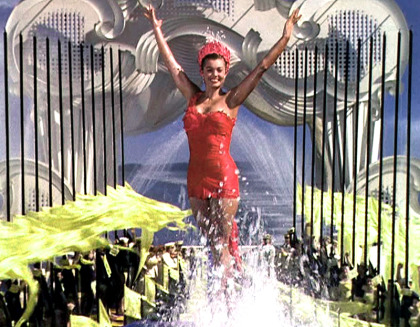
Esther Williams dans EASY TO LOVE (Désir d’amour) de Charles Walters (1953)
Esther Williams est née à Hollywood, faubourg de Los Angeles, le 8 août 1921. A quinze ans, elle avait remporté tous les concours nationaux de natation, était championne de la côte du Pacifique et se préparait à représenter les États-Unis aux Jeux olympiques qui devaient se tenir en Finlande mais qui furent annulés en raison de la guerre. Elle était vendeuse et mannequin pour vêtements de sport quand l’impresario Billy Rose se trouva dans l’obligation de remplacer sa vedette dans le spectacle nautique qu’il était en train de monter pour l’Exposition de San Francisco. La place fut offerte à Esther Williams ; la perspective d’un salaire de 150 dollars par semaine et de travailler avec Johnny Weissmuller eurent raison des hésitations de la jeune femme.
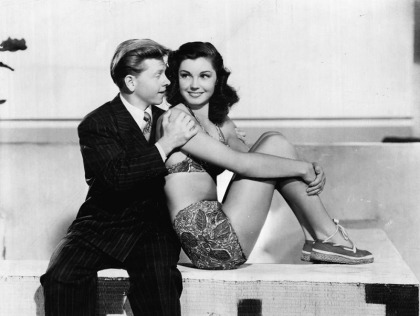
Mickey Rooney et Esther Williams dans ANDY HARDY’S DOUBLE LIFE (La Double Vie d’André Hardy) de George B. Seitz (1942)
Pour ses débuts au cinéma, Esther Williams fut la petite amie de Mickey Rooney dans Andy Hardy’s double life (1942) dans lequel elle put mettre en valeur ses talents nautiques. Sa merveilleuse technique fit également impression dans Bathing Beauty (Le Bal des sirènes, 1944), qu’elle interpréta aux côtés de Red Skelton. L’extraordinaire succès de ce film lui valut d’apparaître dans un nouveau ballet nautique dans Ziegfeld Folies (1946).
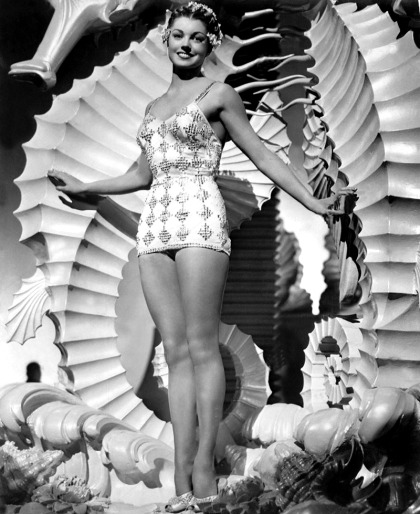
BATHING BEAUTY (Le Bal des sirènes, 1944) – George Sidney avec Red Skelton, Esther Williams
En 1944, après un mariage malheureux, Esther Wiliams partagea son temps entre son travail à la MGM et Ben Gage, un beau sergent de l’armée américaine. Elle l’épousa en 1945 et, de l’avis du public, ils formaient le plus beau couple de Hollywood. La carrière de l’actrice se poursuivit avec Easy to wed (Ève éternelle, 1946), remake de Libelled Lady (Une fine mouche, 1936) et avec le film qui l’éleva à la dignité de star : Fiesta (Senorita toréador, 1947) dans lequel elle incarnait la sœur jumelle du torero campé par Ricardo Montalban.
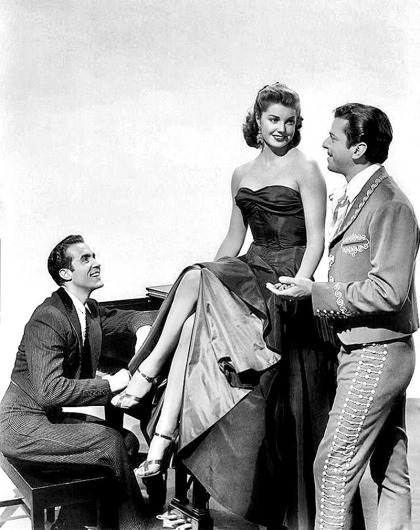
Ricardo Montalban, Esther Williams et John Carroll – FIESTA (Sénorita Toréador) de Richard Thorpe (1947)
A l’écran, sa prestance était particulièrement magnifiée par le Technicolor. Dans This time for keeps (Le Souvenir de vos lèvres, 1947), elle jouait le rôle d’une nageuse remarquée par le fils d’un célèbre chanteur et dans On an Island with you (Dans une île avec vous, 1948), elle était une actrice qui devait tourner un film dans les mers du Sud.
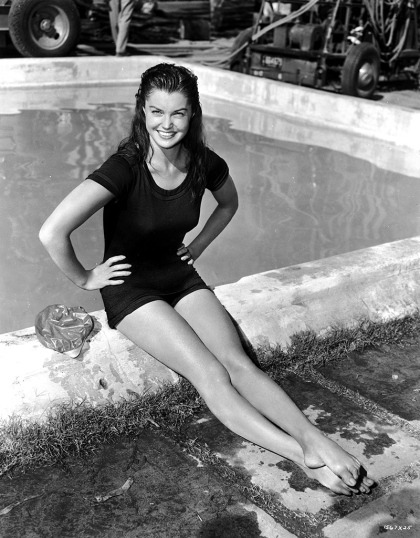
Esther Williams dans ON AN ISLAND WITH YOU (Dans une île avec vous) de Richard Thorpe (1948)
Dans Take me out to the baIl Game (Match d’amour, 1949), elle se trouvait à la tête d’une équipe de base-ball qui comptait Frank Sinatra et Gene Kelly parmi ses membres. Dans Neptune’s Daughter (La Fille de Neptune, 1949), Esther Williams incarnait une championne de natation et chantait, avec Ricardo Montalban, le duo “Baby, Ifs Cold Outside” qui remporta l’Oscar du meilleur thème musical.
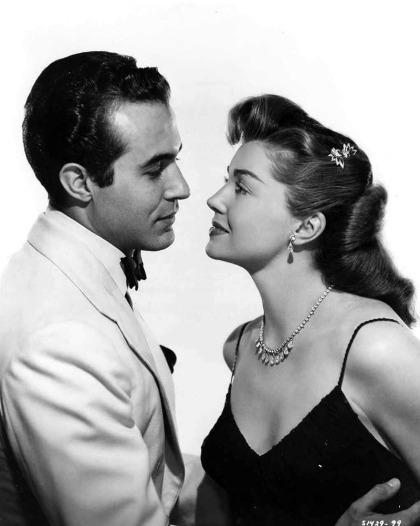
Ricardo Montalban et Esther Williams dans NEPTUNE’S DAUGHTER (La Fille de Neptune) d’Edward Buzzell (1949).
Au cours des années suivantes, de 1950 à 1952, Esther Williams tourna également quatre brillantes comédies musicales : Duchess of Idaho (Jamais deux sans toi), Pagan love song (Chanson païenne), tous deux de 1950, Texas Carnival (Carnaval au Texas, 1951) et Des jupons à l’horizon (Skirts Ahoy !, 1952).
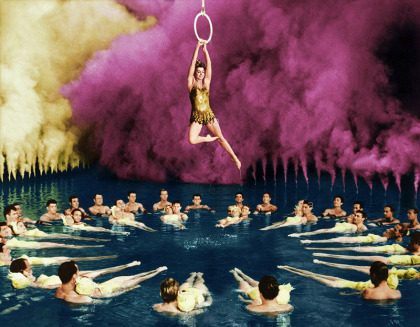
Esther Williams dans MILLION DOLLAR MERMAID (La Première Sirène) réalisé par Mervyn LeRo (1952)
Million Dollar Mermaid (La Première Sirène, 1952) fut son film le plus important. Dans cette biographie filmée, elle incarnait le personnage d’Annette Kellermann, première star de spectacles nautiques et grande vedette du muet. Le scénario évoquait la vie d’Annette Kellermann qui, frappée par la poliomyélite encore enfant, avait fini par triompher de son infirmité, apprenant à nager et à plonger jusqu’à devenir championne internationale.
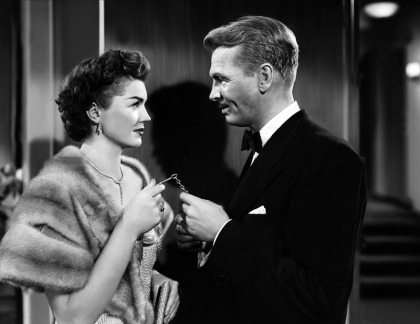
Esther Williams et Van Johnson dans DUCHESS OF IDAHO (Jamais deux sans toi) de Robert Z. Leonard (1950).
Elle tourna encore trois films pour la MGM : Dangerous when wet (Traversons la Manche, 1953), dans lequel toute une famille de nageurs décide de traverser la Manche à la nage ; Easy to Love (Désir d’amour, 1953) et Jupiter’s Darling (La Chérie de Jupiter, 1955). Ce fut le dernier film d’Esther Williams pour la MGM.

Esther Williams et Tom & Jerry dans DANGEROUS WHEN WET (Traversons la Manche) de Charles Walters (1957)
En 1956, elle travailla pour l’Universal et tourna un thriller dans lequel elle incarnait un professeur de musique menacée par un jeune psychopathe. The Unguarded Moment (L’Enquête de l’inspecteur Graham, 1956) fut un extraordinaire succès mais les goûts du public changeaient et la carrière de la star touchait à sa fin. Après avoir divorcé d’avec Ben Gage, elle épousa l’acteur Fernando Lamas et se consacra à apprendre la natation aux petits aveugles de Los Angeles.
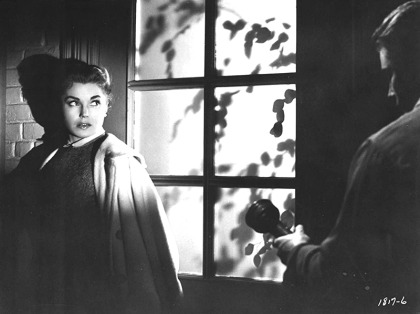
Esther Williams dans THE UNGUARDED MOMENT (L’Enquête de l’inspecteur Graham) réalisé par Harry Keller (1956)
A voir également
ZIEGFELD FOLLIES – Vincente Minnelli (1945)
“A Water Ballet” Un ballet nautique conçu et exécuté par Esther Williams.
Director : Merril Pye
BATHING BEAUTY (Le Bal des sirènes, 1944) – George Sidney avec Red Skelton, Esther Williams
Pour préparer la sortie de Bathing beauty (Le Bal des sirènes), les publicitaires de la Metro-Goldwyn-Mayer ont installé à Times Square un immense panneau d’affichage montrant Esther Williams en plein plongeon, agrémenté du slogan : « Venez, elle est bonne ! ». Le moins qu’on puisse dire, c’est que le public a répondu à l’invitation, faisant même un triomphe à la comédie musicale de George Sidney. Lire la suite…
TAKE ME OUT TO THE BALL GAME – Busby Berkeley (1949) – Frank Sinatra, Esther Williams, Gene Kelly, Betty Garrett
Quand Busby Berkeley met en scène Take Me Out to The Ball Game (Match d’amour) au cours de l’été 1948, il ignore qu’il s’agit de sa dernière réalisation. L’homme qui a dominé la comédie musicale américaine des années 30 va en effet se voir détrôné par une nouvelle génération de cinéastes et de chorégraphes, dont Gene Kelly sera le représentant le plus fameux. Lire la suite…
Lorsque en 1941, Esther Williams signa un contrat avec la MGM, personne n'imaginait alors qu'en l'espace de dix ans elle deviendrait la plus grande étoile de cette compagnie et que pendant deux années consécutives elle serait une des stars du box-office. Elle-même affirmait volontiers qu'elle était avant tout une nageuse avant d'être une actrice. Lorsque en 1941, Esther Williams signa un contrat avec la MGM, personne n'imaginait alors qu'en l'espace de dix ans elle deviendrait la plus grande étoile de cette compagnie et que pendant deux années consécutives elle serait une des stars du box-office.
1 note
·
View note